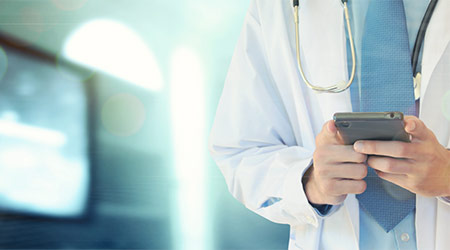Cell phones and electronic tablets are being used with increasing frequency in healthcare to facilitate communication, education and documentation. Multiple studies have demonstrated that just like the hands that hold them, these devices are commonly contaminated with pathogenic bacteria and viruses, creating a risk of transmission and infection.
Cell phones travel with physicians and healthcare workers (HCW), becoming what could be considered our “third hand.”Our hands contaminate phones, and phones contaminate our hands. Both can contaminate the healthcare environment. Not surprisingly the bacteria found on phones are often identical to strains on HCW hands. And some of these are the causative pathogens for healthcare associated infection (HAI) such as methicillin-resistant Staphylococcus aureus (MRSA).
Currently, the most common method of cleaning these devices is manual wiping with germicide-impregnated disposable wipes. However, an alternative technology now being used with increasing frequency in healthcare is ultraviolet-C (UV-C) disinfection. PhoneSoap is an example of a UV-C device that has been proven in a number of research trials to effectively and efficiently disinfect cell phones used in the healthcare environment.
During 2020, the Children’s Hospital of Los Angeles completed and published a prospective investigational study designed to evaluate the PhoneSoap UV-C device for disinfecting mobile phones used by nurses and residents during 12-hour shifts on a pediatric medical/surgical unit.
This study was undertaken to determine the efficacy of this alternative method of phone cleaning in place of cleaning with germicidal wipes which has numerous disadvantages. The primary drawback with the use of germicidal wipes is the time involvedwhich includes donning gloves, wiping all sides and surfaces of the phone, permitting the prescribed dry time, and doffing gloves. This can take as long as 2-4 minutes each time. Additionally, the chemicals in the wipes are not always compatible with the fragile electronic devices, and can cause damage.
The hypothesis for the study was that the UV-C device would provide equal or better disinfection efficacy, in addition to improved efficiency and convenience when compared to the current method of wiping cell phones with disposable germicide-impregnated cleaning cloths. The UV-C device contains 16 UV-C bulbs and provides 360-degree disinfection during the 30-second cleaning cycle. The motion-activated door allows for touch-free operation, reducing the risk of contaminating the external surface of the UV-C device and re-contamination of phones.

 Building Sustainable Healthcare for an Aging Population
Building Sustainable Healthcare for an Aging Population Froedtert ThedaCare Announces Opening of ThedaCare Medical Center-Oshkosh
Froedtert ThedaCare Announces Opening of ThedaCare Medical Center-Oshkosh Touchmark Acquires The Hacienda at Georgetown Senior Living Facility
Touchmark Acquires The Hacienda at Georgetown Senior Living Facility Contaminants Under Foot: A Closer Look at Patient Room Floors
Contaminants Under Foot: A Closer Look at Patient Room Floors Power Outages Largely Driven by Extreme Weather Events
Power Outages Largely Driven by Extreme Weather Events